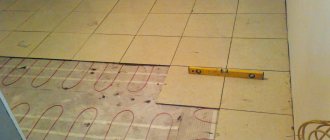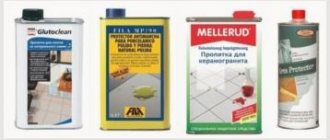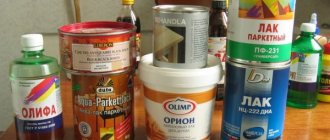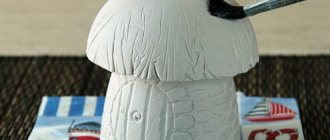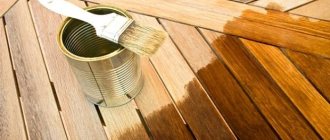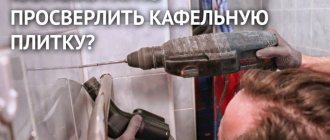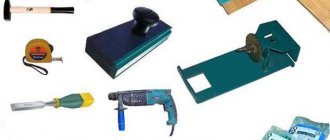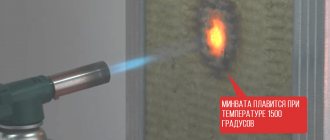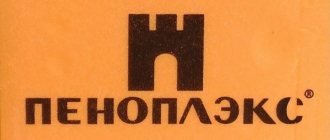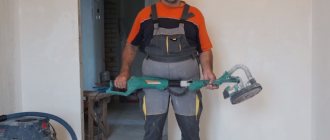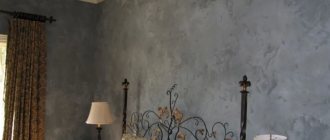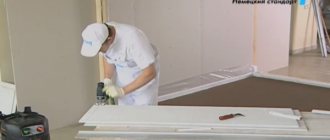The modern building materials market offers such a large number of options for facade finishing that it is easy for an inexperienced person to get confused.
Before you go shopping, you need to familiarize yourself with the possible options and choose the right one at home. Today we’ll talk about porcelain stoneware and how good it is for façade finishing.
Hinged ventilated facade made of porcelain stoneware
Most modern residential property owners pay great attention to the appearance of their home. Therefore, the design of the facade becomes a primary task after the walls are erected. In Moscow, the technology of hinged ventilated facade is very popular, for the cladding of which various finishing materials are used. Walls can be covered with plaster, fiber cement panels, siding and other methods. Another common method is laying natural or artificial stone. One of the most modern popular cladding options is porcelain stoneware.
The material perfectly protects from negative environmental influences. The air gap, which is provided by the ventilation facade technology, will allow air to circulate freely under the cladding, preventing moisture from accumulating. Porcelain tiles protect the walls of the building well and prevent the insulation from becoming damp and freezing. It is less susceptible to various types of influences than its analogues. The ventilated facade system allows the use of a wide variety of facing materials, in which porcelain stoneware is one of the leaders.
Specific Features
Facade porcelain stoneware, the production of which is developing every year, is a popular and in-demand material. The following components are used for its manufacture: clay, sand, feldspar. Thanks to modern dyes, you can get porcelain tiles of absolutely any color and shade. The manufacturing technology of the slabs involves firing them at a temperature of 1200 °C, due to which the porcelain stoneware obtains high strength characteristics. It surpasses even natural stone in strength.
Installing a façade with porcelain stoneware slabs is a responsible task that is best left to specialists. Porcelain tile cladding is a wonderful way to transform the exterior walls of buildings.
The many obvious advantages of porcelain stoneware slabs make it possible to beautifully and functionally design any facade. Porcelain tiles are resistant to water and temperature fluctuations. Technological research has proven that the service life of porcelain stoneware can reach up to fifty years, so finishing made from such material will be reliable and durable. It is worth noting its high strength: even under intense loads, the panel will not be deformed. The products exhibit good resistance to abrasion and wear, which is very important in the construction of facades. The obvious advantage of porcelain stoneware is that, thanks to it, the facade will retain its original attractive appearance for a long time. The relatively high cost of porcelain tiles per 1 m2 is fully compensated by a number of advantages. Porcelain stoneware with a smooth surface is used for modern building facades. The thickness of the slabs may vary by several mm. The cost of porcelain tiles that have undergone rectification will be higher. It features an ideal geometric shape and precise dimensions. In Moscow, the price per 1 m2 may vary depending on key features and the country of origin.
Differences from other types of facade tiles
Porcelain tile cladding has two main competitors - natural stone and ceramic tiles (regular, clinker, terracotta). When comparing a product with a natural analogue, the first thing I would like to note is the more favorable price of the artificial material.
As already mentioned, porcelain stoneware costs much less than natural stone, but its properties are practically not inferior to it . Moreover, the strength of the artificial material is superior to its natural counterpart.
Another point is the appearance of the products.
Porcelain tiles compete with such types as:
- ceramic;
- clinker;
- basement;
- under a stone;
- under brick;
- basement
IMPORTANT!
Natural stone is formed in nature, so blocks can have different shades and different numbers of veins. The texture and color of porcelain stoneware are controlled in production, which makes it possible to obtain more identical samples.
When comparing porcelain tiles with ceramics, there is nothing to say about the superiority of the former in terms of strength - it is indisputable. There is a significant difference between analogues in the level of water absorption: in the first case this figure is up to 0.5%, in the second – up to 10% .
Hence the conclusion - porcelain stoneware is much better suited for façade cladding than ceramics. True, the latter also has a noticeable advantage - due to its higher porosity, it weighs less than ceramic granite.
Installation of a ventilated facade made of porcelain stoneware: advantages
Like any other modern cladding material, porcelain stoneware has a number of obvious advantages:
- Attractive aesthetic appearance. Porcelain tiles will give the building a unique and sophisticated look.
- Wide and rich color palette.
- A facade panel of this type is an opportunity to implement any design idea.
- Simple and quick installation.
- The ability to replace one fragment without dismantling the entire structure.
- Shows excellent resistance to ultraviolet radiation.
- Provides sound insulation.
- Completely fireproof.
- This is an environmentally friendly material that does not pose a risk to human health.
- Sufficiently resistant to dynamic and static loads.
- Easy to care for.
- It has a long service life.
- Makes it possible to cladding the façade at any time of the year.
- Does not require complex and time-consuming preparatory work.
- The price is affordable and differs less than the cost of composite finishing materials.
- Visually it looks like expensive natural stone.
- Variety of types, colors and shades.
Among the disadvantages of a ventilated facade made of porcelain stoneware, we highlight:
- Impressive weight, which requires the installation of an ultra-reliable subsystem;
- The installation price can be quite high, since the weight of porcelain stoneware is large.
Installing a suspended ventilated facade using this material is an investment for more than a dozen years, so the selection and purchase of porcelain stoneware must be approached with the utmost seriousness. Modern technologies make it possible to produce durable and reliable porcelain tiles that will perfectly protect walls from external influences. When buying it, you should not forget about the quality of the components. Reliable components are the key to long-term operation of the facade. An experienced specialist can help you choose porcelain tiles and components.
Specifications
Porcelain tiles have the following parameters:
- frost resistance – up to 50 cycles of freezing and thawing;
- water absorption – 0.05 – 0.5%;
- density – 2400 – 2700 kg/m3. Roughly equivalent to the specific gravity of glass;
- resistance to mechanical stress: scratch resistance - more than 6 Mohs, fracture strength - more than 27 N / mm2.
- Dimensions - 600 x 600.
Manufacturers
Facade cladding with porcelain stoneware is increasingly gaining popularity. Consequently, you can find products from more than one manufacturer on the market. Below we consider the most popular manufacturers of porcelain tiles,
whose product can be purchased in any specialized store:
- Atlas Concorde is an Italian brand. It is a world leader in the production of porcelain stoneware. The company strives for continuous modernization of production, so its products are of impeccable quality. In the production of porcelain stoneware slabs, advanced modern equipment, innovative ideas and our own developments are used.
- Italon is a Russian company that produces products of the highest quality. Relying on the experience and technology of Italian partners, the company implements high-tech production of reliable and high-quality porcelain stoneware. The products are characterized by the highest aesthetic quality, attractiveness and best performance properties. The best option for exclusive finishing of external walls.
- New Pearl is a Chinese factory that is part of the largest concern for the production of ceramic tiles. Every year the company produces up to 45 million m2 of tiles. The products of this manufacturer have been supplied to the European market for quite a long time. Thanks to innovative developments and strict quality control, the product of this manufacturer is one of the most reliable.
- Fiorano is a Chinese product that is very popular in the domestic market. Production capacity, professionalism of staff and the use of high-quality raw materials allow this company to produce a product of decent quality. Porcelain tiles from this manufacturer are widely used for exterior and interior decoration.
- "Ural Granite" is a Russian trademark. The company produces porcelain tiles that have increased resistance to low temperatures. In addition to basic quality indicators, in the process of manufacturing the material, the company’s experts take into account other parameters: curvature of the front side, linearity of the edges, resistance to contamination. The products are quite competitive.
- ESTIMA is a domestic brand. This company was one of the first to launch the production of porcelain stoneware products on an industrial scale. The use of advanced technologies and modern equipment makes it possible to produce top-class products. The manufacturer's assortment includes more than twenty types of porcelain tiles. It can be used alone or in combination with other elements.
- KERAMA MARAZZI is the most popular and reputable Italian brand that specializes in the production of ceramic tiles. The slabs from this manufacturer look expensive, solid and presentable, imitating real stone in appearance.
- GRASARO is a domestic production of porcelain stoneware. The company uses foreign raw materials, but production is carried out on Russian equipment. In terms of quality indicators, it is in no way inferior to foreign analogues.
Types of porcelain tiles
You can find several types of products on sale, differing from each other in structure and surface type.:
- Sanded – matte products with a rough texture to the touch. During manufacturing they are processed with diamond discs.
- Matte (unpolished) – from the name it is clear that the products are not polished. This cladding is distinguished by its lack of shine, but has high technical parameters and a lower cost compared to other analogues.
- Satin (polished) - the surface is coated with mineral salts and acids, as a result of which the product acquires a slight shine. This does not affect the structure in any way, and in terms of characteristics the material is similar to its matte counterpart. True, it costs more.
- Mirror - the surface is not only ground or polished to a shine.
- Glazed - products are coated with glaze before firing, which gives them a bright glossy shine.
- Semi-polished - by cutting away any irregularities on the outside of the tile, a surface is formed that combines glossy and matte effects.
- Structured – products with a relief structure that imitate various materials (wood, stone, leather, etc.).
- Technical – very similar to products made from natural granite. They are particularly strong and durable.
Cost and choice of material
The installation of a ventilated façade made of porcelain stoneware requires detailed and correct calculations. The final cost of installing a porcelain stoneware facade will directly depend on many factors: brand and type of slabs, dimensions, complexity of installation work and even weather conditions. You should immediately take into account that porcelain stoneware is not a cheap finishing option, and therefore its installation will not be cheap. And even if the price of the material per m2 seems very insignificant, the installation cost will be somewhat more expensive. Ideally, the purchase of materials should be carried out by the customer together with a professional.
First of all, when choosing porcelain stoneware, pay attention to the following factors:
- Multiplicity of slabs. To avoid the appearance of unnecessary seams, it is necessary to design the cladding so that only whole slabs are used.
- Size. The finer the material, the more seams there will be. This parameter should also be taken into account.
- Caliber. The greater the difference in the sizes of the slabs, the more difficult their installation will be and the aesthetics of the cladding will decrease somewhat.
- Hue and texture. This nuance should definitely be taken into account so that the material fits into the overall style and design of the building.
- Operating parameters (resistance to wear, temperature fluctuations, moisture).
- Price.
A hinged ventilated façade made of porcelain stoneware will last a very long time if you choose the material wisely and carry out the installation professionally.
Which porcelain stoneware is suitable for a ventilated façade?
Not every porcelain stoneware can be used for a ventilated façade. The limitation is its thickness.
The standard thickness of porcelain stoneware for ventilated facades is 10-12mm. Eight mm tiles are not recommended.
At altitude, incl. Due to wind loads, high pressure occurs on porcelain stoneware. In addition, the clasp - this is a structural element of the ventilation facade - is made according to standard stamps. And the clamp foot is designed for the standard thickness of façade porcelain stoneware.
Sometimes porcelain stoneware is set on a mortar, so you can tile the base, entrance area, edge, first floor. In this case, the lighter the tile, the longer it will last, all other things being equal. But to install a ventilated facade, porcelain stoneware must be at least 10mm.
The exception to the thickness of porcelain stoneware is the latest ultra-thin panels, three millimeters thick and up to three meters wide.
In this case, thin porcelain stoneware sits on glue and a horizontal strip. In fact, this is a completely different type of cladding, although it is called “thin porcelain stoneware”. Let's look at it in more detail below.
Facade finishing with porcelain stoneware
Porcelain stoneware facades are structurally composed of several components:
- Frame. It is installed on an external wall. A frame will be needed to attach porcelain tiles. Structurally, it consists of a system of guide profiles and auxiliary elements; installation is carried out on a load-bearing wall using dowel-nails. Made from stainless steel or aluminum. There are two types - horizontal and vertical. A special bracket system is installed using fastenings. Thanks to the specific design of the brackets, the size of the gap can be adjusted.
- Insulation and waterproofing layer. Typically, the following materials are used to insulate external walls: polystyrene foam, mineral wool or polyurethane foam. It is advisable to familiarize yourself with the features of each type of insulation, which are given on the packaging. A specific insulation material is suitable for each type of building material.
- Directly facing. Porcelain tiles must be stable, not lose brightness, and not be susceptible to aggressive substances.
- Additional nodes and elements. Additional units and components include a variety of products and additional elements. These can be various rubber gaskets, inserts that play the role of decor. All components and elements are made of various materials: aluminum, polymers, polyurethane.
Possible mistakes
Separately, I would like to talk about the most common errors that arise during the process:
- Installing a supporting frame in the cold. So, after installation in cold weather, when the temperature rises, there is a high probability that the fasteners will weaken, and the fastening subsystem will begin to lose its strength and rigidity.
- Installation of brackets without compensation spacer. This will lead to a gradual weakening of the fasteners due to the fact that the material will compress and expand under the influence of temperatures with each cycle.
- Coincidence of seams when installing several layers of insulation. Because of this, cold bridges will form, which will significantly reduce the effectiveness of thermal insulation.
- Setting the clamps too close. Because of this, the slab will fit tightly into the fasteners, and then when heated under the sun, the slab may simply burst and this will cause internal stress.
Try to avoid such mistakes, and then the result will definitely please you for a long time.
Ventilated facade made of porcelain stoneware installation technology
Installation of a ventilated facade made of porcelain stoneware can be performed using several methods, depending on the type of fastening:
- Hidden fastening type. The installation of the facade on the frame subsystem is carried out using a variety of anchor elements. This fastening method makes it possible to achieve the most aesthetic effect; joints and seams will not be visible. Some installers use several technologies: the choice depends on the frame subsystem used. One of the popular methods is the use of agraph. First, a small trapezoid-shaped recess is drilled from the inside of the slab. An anchor bolt is inserted and secured into this recess, to which hinged fasteners called “agraphs” are screwed. Porcelain tiles are attached to the base using agraf.
- Use of clamps. Clamps are plates; they are most often made of stainless steel or a special type of aluminum. Such products are equipped with special curved “legs”, and facade tiles are inserted into them. The clamps are attached to the frame using self-tapping screws or bolts. This technology is the most popular due to its simplicity and efficiency.
Buying Tips
Similar articles
- About brands and manufacturers of thin porcelain tiles...
About brands and manufacturers of thin
porcelain tiles
: Arkhskin, Kerlit, Laminam and others.
...
Popular articles.
Facade
"Alucobond" - what is it. Read more - Comparison and rating of subsystems for ventilated…
The fastening element for the cladding can be a slide with glue (to secure
façade
cassettes) or a clamp (for
porcelain tiles
) or a rivet (for fiber cement)... Read more - Installation of porcelain tiles on a ventilated facade
Facade
fasteners for
porcelain tiles
: German Keil bolt. The method of hidden fastening came to us from Germany. Read more - Review of façade slabs: hpl panel, rock panel, thin…
Due to which
the façade
slabs have a small radius, i.e.
may be bent. Porcelain tiles
are durable yet flexible. Read more - Facade “ceramics”: volumetric terracotta panels
Let’s immediately make a reservation that
we won’t talk façade porcelain tiles And we have such an article. Read more - Learning to cut façade porcelain tiles
Porcelain stoneware
tiles can be considered one of the most versatile building materials, which is used for finishing floors and walls... Read more
Installation stages
- Preparatory work. At this stage, the craftsmen must assess the condition of the wall. It is desirable that the surface is smooth, without flaws or defects. Large defects must be eliminated in an optimal way.
- Performing markings. It is carried out strictly in accordance with the project. Some craftsmen work using laser levels.
- Marks are made at certain distances - at the intersection of horizontal and vertical lines where frame fasteners will be placed.
- The brackets are installed using a hammer drill.
- Installation of thermal insulation layers and waterproofing. The insulation layer must be laid on top of the vapor barrier. Most often, mineral wool, polystyrene foam, and polyurethane foam act as insulation. Expanded polystyrene boards are mounted with dowels or glue. When purchasing insulation, you should pay attention to the thickness of the material; it is indicated in cm.
- Installation of frame profile. It is necessary to proceed with the installation of the frame only after completion of the installation of the heat-insulating layer. The racks are first installed on the walls in a vertical position. Racks are used T-shaped, corner or U-shaped. A specific type is used to solve various problems. The main type of profiles are T-shaped, they are used to develop a flat plane on the wall surface. Such racks play a key load-bearing role. In the future, special clamps will be installed on them, which will perform the function of fixing porcelain stoneware. In some cases, jumpers can be used as additional elements.
- After the supporting frame is installed, they begin cladding with porcelain stoneware. Taking into account the shape of the plates, the clamps are fastened to the profile.
- The slabs themselves are fixed to the wall surface in rows horizontally, and work begins from the bottom. At the joints in the corners, the slabs are cut and adjusted to the required parameters. For these purposes, a grinder with a diamond wheel is used.
A ventilated facade made of porcelain stoneware, the installation technology of which is relatively simple, will last for several decades.
